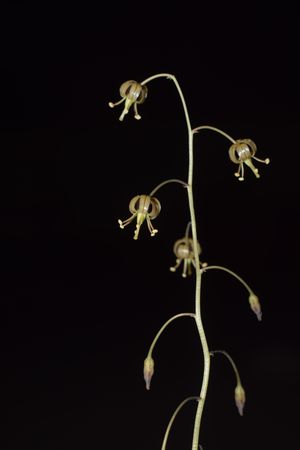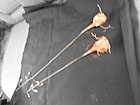Note: This is a project under development. The articles on this wiki are just being initiated and broadly incomplete. You can Help creating new pages.
Difference between revisions of "Drimia indica - Kolakanda"
(→External Links) |
|||
| Line 1: | Line 1: | ||
[[File:Drimia indica - open flowers.jpeg|thumb|right|''Kolakanda'', ''Drimia indica'']] | [[File:Drimia indica - open flowers.jpeg|thumb|right|''Kolakanda'', ''Drimia indica'']] | ||
'''Kolakanda''' is a bulbous perennial plant with delicate maroonish pendant flowers that bloom from leafless bulbs during the summer. The strap shaped leaves appear in the rainy season. The bulb is eaten by locals. Kolakanda is found throughout India in stony or gravelly substrate. | '''Kolakanda''' is a bulbous perennial plant with delicate maroonish pendant flowers that bloom from leafless bulbs during the summer. The strap shaped leaves appear in the rainy season. The bulb is eaten by locals. Kolakanda is found throughout India in stony or gravelly substrate. | ||
| − | |||
==Uses== | ==Uses== | ||
| − | {{Uses|Skin diseases}}, {{Uses|Cold}}, {{Uses|Cough}}, {{Uses|Difficulty in micturition}}, {{Uses|Cardiac problems}}, {{Uses|Intestinal worms}} | + | {{Uses|Skin diseases}}, {{Uses|Cold}}, {{Uses|Cough}}, {{Uses|Difficulty in micturition}}, {{Uses|Cardiac problems}}, {{Uses|Intestinal worms}} <ref name="Uses"/> |
| − | <ref name="Uses"/> | ||
==Parts Used== | ==Parts Used== | ||
| Line 12: | Line 10: | ||
==Common names== | ==Common names== | ||
| − | {{Common names|kn= | + | {{Common names|kn=Kaadu bellulli, Naayiulli, Seeme nari eerulliadavi-irulli, Bheemana ulli|ml=Kanthanga, Kattulli|sa=Asmantaka, Kolakanda, Krimighna, Panjalaputakanda, Putalu, Suputa, Vana-palandam|ta= Ciruvenkayam, Kaattu vengayam, Kakunarakavulli, Kattuvengayam|te=Adavithellagadda, Kaazagadda, Nakka-vulli-gadda|hi=Ban piaz, Jangli piaz, Janglikanda|en=}} |
<ref name="Common names"/> | <ref name="Common names"/> | ||
| Line 36: | Line 34: | ||
==Identification== | ==Identification== | ||
===Leaf=== | ===Leaf=== | ||
| − | {{Leaf|Simple|Rosette|Bulbous, scapigerous herbs; bulbs tunicated, 3.5-6 x 2.5-6.5 cm, globose-conical. Leaves radical with sheathing base, 13-25 x 0.6-2.5 cm, linear, lanceolate or lorate. }}<ref name="Leaf"/> | + | {{Leaf|Simple|Rosette|Bulbous, scapigerous herbs; bulbs tunicated, 3.5-6 x 2.5-6.5 cm, globose-conical. Leaves radical with sheathing base, 13-25 x 0.6-2.5 cm, linear, lanceolate or lorate.}}<ref name="Leaf"/> |
===Flower=== | ===Flower=== | ||
| − | {{Flower|Bisexual|Scape|Purplish brown|6| Scapes 17-45 cm tall, erect, purpish brown, 4-15-flowered. | + | {{Flower|Bisexual|Scape|Purplish brown|6| Scapes 17-45 cm tall, erect, purpish brown, 4-15-flowered.}} |
===Fruit=== | ===Fruit=== | ||
| − | {{Fruit|A capsule|10-20 x 5-10 mm|| | + | {{Fruit|A capsule|10-20 x 5-10 mm||Brownish yellow|Seeds 4-10 in each cell, 4-7 x 3-4 mm, winged.}} |
===Other features=== | ===Other features=== | ||
| Line 69: | Line 67: | ||
<gallery class="left" caption="" widths="140px" heights="140px"> | <gallery class="left" caption="" widths="140px" heights="140px"> | ||
File:Urginea indica-1-sitheri hill-dharmapuri-India.jpg | File:Urginea indica-1-sitheri hill-dharmapuri-India.jpg | ||
| − | |||
| − | |||
| − | |||
</gallery> | </gallery> | ||
| Line 81: | Line 76: | ||
<ref name="Leaf">[http://keralaplants.in/ "BOTANIC DESCRIPTION"]</ref> | <ref name="Leaf">[http://keralaplants.in/ "BOTANIC DESCRIPTION"]</ref> | ||
<ref name="Common names">[http://envis.frlht.org/bot_search "Vernacular names"]</ref> | <ref name="Common names">[http://envis.frlht.org/bot_search "Vernacular names"]</ref> | ||
| − | |||
</references> | </references> | ||
Revision as of 15:39, 29 April 2020
Kolakanda is a bulbous perennial plant with delicate maroonish pendant flowers that bloom from leafless bulbs during the summer. The strap shaped leaves appear in the rainy season. The bulb is eaten by locals. Kolakanda is found throughout India in stony or gravelly substrate.
Contents
- 1 Uses
- 2 Parts Used
- 3 Chemical Composition
- 4 Common names
- 5 Properties
- 6 Habit
- 7 Identification
- 8 List of Ayurvedic medicine in which the herb is used
- 9 Where to get the saplings
- 10 Mode of Propagation
- 11 How to plant/cultivate
- 12 Commonly seen growing in areas
- 13 Photo Gallery
- 14 References
- 15 External Links
Uses
Skin diseases, Cold, Cough, Difficulty in micturition, Cardiac problems, Intestinal worms [1]
Parts Used
Chemical Composition
Common names
| Language | Common name |
|---|---|
| Kannada | Kaadu bellulli, Naayiulli, Seeme nari eerulliadavi-irulli, Bheemana ulli |
| Hindi | Ban piaz, Jangli piaz, Janglikanda |
| Malayalam | Kanthanga, Kattulli |
| Tamil | Ciruvenkayam, Kaattu vengayam, Kakunarakavulli, Kattuvengayam |
| Telugu | Adavithellagadda, Kaazagadda, Nakka-vulli-gadda |
| Marathi | NA |
| Gujarathi | NA |
| Punjabi | NA |
| Kashmiri | NA |
| Sanskrit | Asmantaka, Kolakanda, Krimighna, Panjalaputakanda, Putalu, Suputa, Vana-palandam |
| English |
Properties
Reference: Dravya - Substance, Rasa - Taste, Guna - Qualities, Veerya - Potency, Vipaka - Post-digesion effect, Karma - Pharmacological activity, Prabhava - Therepeutics.
Dravya
Rasa
Tikta (Bitter), Katu (Pungent)
Guna
Laghu (Light), , Teekshna (Strong)
Veerya
Ushna (Hot)
Vipaka
Karma
Vata
Prabhava
Habit
Identification
Leaf
| Kind | Shape | Feature |
|---|---|---|
| Simple | Rosette | Bulbous, scapigerous herbs; bulbs tunicated, 3.5-6 x 2.5-6.5 cm, globose-conical. Leaves radical with sheathing base, 13-25 x 0.6-2.5 cm, linear, lanceolate or lorate. |
Flower
| Type | Size | Color and composition | Stamen | More information |
|---|---|---|---|---|
| Bisexual | Scape | Purplish brown | 6 | Scapes 17-45 cm tall, erect, purpish brown, 4-15-flowered. |
Fruit
| Type | Size | Mass | Appearance | Seeds | More information |
|---|---|---|---|---|---|
| A capsule | 10-20 x 5-10 mm | Brownish yellow | Seeds 4-10 in each cell, 4-7 x 3-4 mm, winged. | {{{6}}} |
Other features
List of Ayurvedic medicine in which the herb is used
Where to get the saplings
Mode of Propagation
How to plant/cultivate
Season to grow
Soil type
Propagation
Commonly seen growing in areas
Photo Gallery
References
External Links
- Ayurvedic Herbs known to be helpful to treat Skin diseases
- Ayurvedic Herbs known to be helpful to treat Cold
- Ayurvedic Herbs known to be helpful to treat Cough
- Ayurvedic Herbs known to be helpful to treat Difficulty in micturition
- Ayurvedic Herbs known to be helpful to treat Cardiac problems
- Ayurvedic Herbs known to be helpful to treat Intestinal worms
- Herbs with Rhizome used in medicine
- Herbs with common name in Kannada
- Herbs with common name in Hindi
- Herbs with common name in Malayalam
- Herbs with common name in Tamil
- Herbs with common name in Telugu
- Herbs with common name in Sanskrit
- Habit - Herb
- Index of Plants which can be propagated by Seeds
- Index of Plants which can be propagated by Bulbs
- Herbs that are commonly seen in the region of Tropical area
- Herbs
- Asparagaceae
- Ayurvedic herbs that don't have flower, fruit and leaf photos
- Ayurvedic herbs that don't have seed photos

